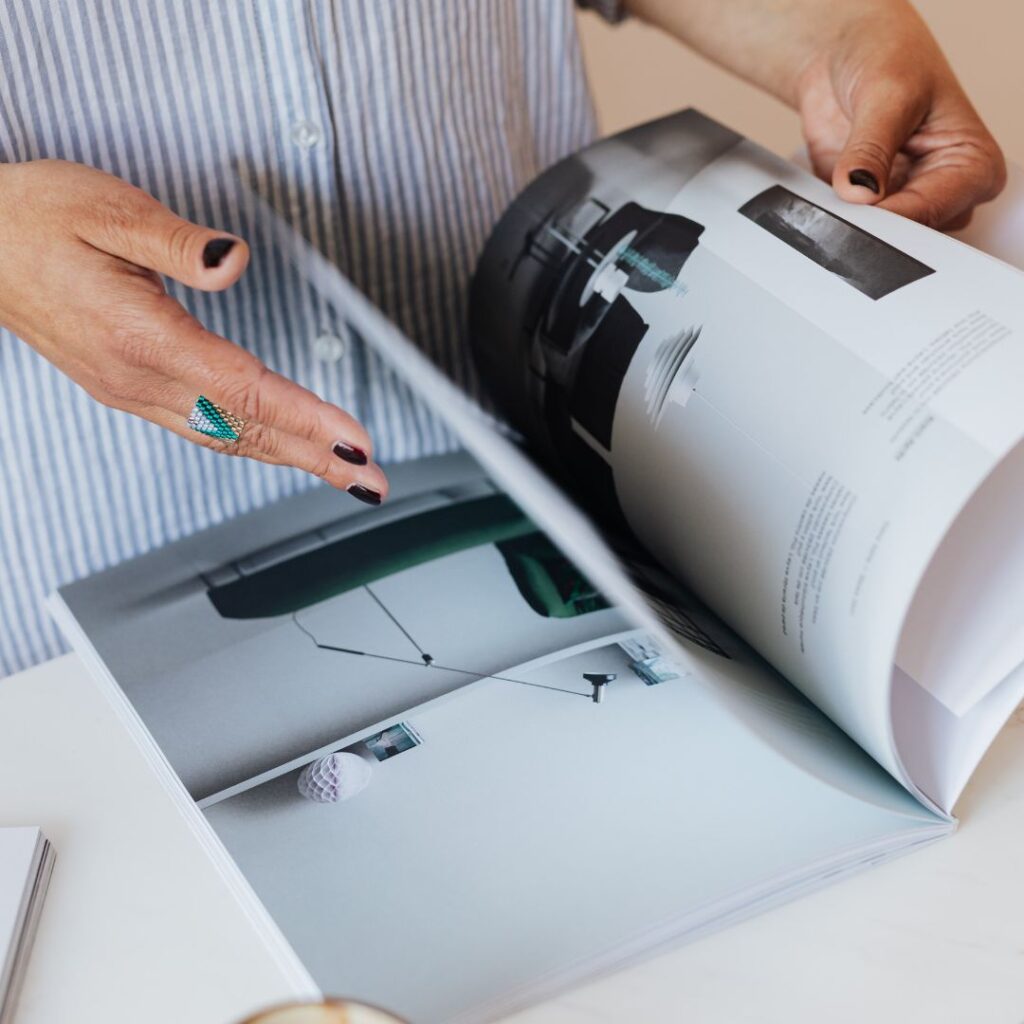Table of Contents
- Introduction
- Understanding the Job Description of a Creative Director
- The Relationship Between Creative Directors and the Publishing Industry
- The Impact of a Creative Director on Publication Success
- How to Become a Successful Creative Director in the Publishing Industry
- Creating A Strong Resume as a Creative Director
- Conclusion
Introduction
The write-up discusses the vital role of a creative director in publishing.
Key to the publishing industry, a creative director plays a crucial role in overseeing a publication’s visual identity and creative direction. The major responsibilities involve developing concepts, guiding design, commissioning photography, and collaborating with editors to ensure engaging content.

The creative director shapes the look and feel of a publication across print and digital platforms. They lead the art department and work closely with graphic designers, typesetters, photographers, illustrators, and other creatives. Their aesthetic vision brings cohesion to the publication and enhances the reader’s experience.
The creative director is instrumental in establishing a publication’s unique visual style by spearheading the creative process. They find ways to innovate within the existing brand identity. The creative director also ensures that the imagery, typography, layout, and other design elements align with the publication’s values and goals.
In the fast-paced, competitive publishing world, the role of the creative director is more crucial than ever. A strong creative vision attracts readers’ attention and differentiates the publication in a saturated media landscape. The creative director ultimately helps drive the success and longevity of any publication.
This section provided a brief overview of the creative director’s far-reaching responsibilities. The next section will delve deeper into the job duties and qualifications required for this multifaceted role.
Understanding the Job Description of a Creative Director
A creative director in the publishing industry has a multifaceted and demanding role. Here are some of the key responsibilities and required skills for this important position:
Tasks and Responsibilities
A creative director’s primary duty is to oversee a publication’s visual identity and creative direction. This involves:
- Developing the overall design aesthetic for the publication, including typography, color schemes, layouts, etc., that suit the target demography and audiences well. A creative director also provides art direction for photo shoots, illustrations, and other visual elements.
- Collaborating with editors and content writers on how visuals best complement written content. A creative director leads and manages the publication’s design team throughout the publication or production.
- Facilitating team collaboration. Collaboration is key in creative work, and the creative director plays a crucial role in fostering a collaborative environment. They encourage open communication and idea-sharing among team members, facilitate brainstorming sessions, and promote cross-functional collaboration.
- Presenting concepts to stakeholders. Creative directors are often the main point of contact between the creative team and stakeholders such as clients, executives, or marketing teams. They present and pitch concepts, designs, and strategies to these stakeholders, ensuring that the creative vision aligns with their expectations and goals.
- Ensuring brand and corporate image consistency across print and digital platforms.
- Setting budgets and deadlines: Creative directors are responsible for establishing project budgets and allocating resources effectively. They work closely with clients, account managers, and finance departments to determine the financial scope of each project.
- Staying on top of design trends and innovations in the industry. An excellent creative director always stays ahead of the others and possesses a magnificent ability to become a trendsetter.
Required Skills and Qualifications
To be successful as a creative director in publishing, the following skills and qualifications are essential:
- Degree in graphic design, fine arts, or related field.
- 5+ years of design experience, ideally in publishing.
- Expertise in design software like Adobe Creative Suite.
- Strong portfolio demonstrating visual storytelling and layout skills.
- Possess the ability to embrace brand identity and work within set guidelines.
- Leadership and project management abilities.
- Excellent communication and collaboration skills.
- Passion for printed media and publishing.
The most effective creative directors combine creative talent with business acumen, managerial skills, and an ability to turn ideas into tangible, high-quality layouts and designs.
The Relationship Between Creative Directors and the Publishing Industry
Creative directors are integral members of a publication’s team. They help shape the visual identity and branding of magazines, newspapers, books, and other print and digital publications. Here are some of the key ways creative directors relate to the broader publishing landscape:
Setting the Visual Tone
A creative director’s main responsibility is establishing and maintaining a publication’s visual style. This includes aspects like:
- Typography – selecting fonts, sizes, and line spacing.
- Color palette – choosing colors that represent the brand
- Page layout and typesetting – determining how text and images are arranged
- Cover design – creating eye-catching yet cohesive covers
The creative director ensures all these elements align with the publication’s desired tone and messaging. Their choices directly impact how readers perceive and interact with the content.
Cohesion Across Platforms
Publications today often have both print and digital presences. The creative director maintains cohesion across these platforms through consistent branding. For example, the creative director for a fashion magazine would ensure its website, social media, print issues, and any other channels feel like they are recognizably part of the same brand.
This role is key in the digital age, where publications must optimize content for different mediums while retaining familiarity for their audience.
Collaborating with Editorial Teams
Though creative directors focus on visuals, they work closely with editorial teams to bring stories to life. When an exciting article is planned, the creative director determines the best formatting, art, fonts, and layouts to captivate readers.

This collaboration allows both teams to play to their strengths while creating a cohesive and engaging final product.
In summary, creative directors greatly influence a publication’s identity and success. Their artistic vision combines words, images, and design into an immersive experience for readers. For these reasons, creative directors remain indispensable for any high-quality publishing team.
The Impact of a Creative Director on Publication Success
A creative director plays a pivotal role in shaping a publication’s visual identity and overall success. Their creative vision helps establish the look and feel that resonates with target audiences. By overseeing design, photography, typography, and other visual elements, creative directors directly impact how appealing and engaging a publication is.
For example, Anna Wintour, Vogue‘s long-time creative director, has been instrumental in making the magazine the fashion bible it is today. Her bold creative choices in photography, covers, and layouts made Vogue a cultural force beyond a fashion magazine.
Similarly, Janice Min helped transform the visual presentation of Us Weekly by introducing a more celebrity-focused, photo-driven style. This revamp led to a dramatic sales increase, cementing its popularity.
Bloomberg Businessweek was struggling with declining readership and relevance in the early 2000s. However, when Richard Turley joined as creative director in 2011, he helped reinvigorate the publication with provocative designs and visuals. The shift in creative direction played a big role in the magazine’s revival.
These examples demonstrate how the right creative leader, with a distinct perspective, can reposition publications by challenging conventions. A creative director’s ability to innovate and push boundaries in visual storytelling is often the X-factor that elevates a publication from mediocrity to greatness in readers’ minds.
How to Become a Successful Creative Director in the Publishing Industry
Becoming a successful creative director in publishing requires a unique blend of creative talent, business acumen, and leadership abilities. Here are some tips for aspiring creative directors looking to excel in this field:
Develop a Strong Creative Portfolio
A standout portfolio is crucial for getting your foot in the door as a creative director. Fill your portfolio with examples of concept development, art direction, and design work across print, digital, and social media mediums. Showcase your visual storytelling skills and ability to develop cohesive branding and styles. Update and refine your portfolio regularly.
Gain Relevant Experience
Try to gain experience in graphic design, art direction, copywriting, photography, typography, web design, branding, and other visual arts. Work at agencies, publications, design studios, or in-house creative teams to build your skills. Take on increasing levels of responsibility in creative leadership roles.
Understand the Business Side
Learn how to strategically position brands, connect with target audiences, and drive engagement and sales. Take business, marketing, and data analysis courses to complement your creative expertise. Knowledge of budgets, timelines, and resource allocation is key.
Develop Leadership and Collaboration Skills
Creative directors must be able to lead creative teams, provide vision and guidance, and foster collaboration. Work on your communication, mentoring, project management, and motivational skills. Be able to critique work and articulate your creative vision constructively.
Stay on Top of Trends
Continuously study industry trends, innovations, and disruptions across mediums and platforms. Immerse yourself in the latest techniques and technologies. Adaptability and learning agility are essential to thrive as a creative director in a rapidly evolving landscape.
Build Your Network
Connect with other creative professionals through events, associations, social media, and more. Seek out mentors who can provide wisdom and guidance. Maintain relationships with collaborators throughout your career.
With a dedication to honing your creative and leadership talents, a successful career as a creative director in publishing is certainly within reach.
Creating A Strong Resume as a Creative Director
Creating a strong resume as a creative director for the publishing industry requires highlighting your relevant experience, skills, and accomplishments. You may read up on how to write a resume for a publishing job and look at a resume sample.
Following are some steps to help you craft a compelling resume:
Contact Information
Start with your name, phone number, email address, and LinkedIn profile or portfolio website if applicable.
Professional Summary
Begin with a summary of your professional background, emphasizing your role as a creative director and your expertise in the publishing industry. This concise statement should give potential employers a snapshot of your qualifications and credentials.
Work Experience
Detail your work history, starting with the most recent job (reverse chronological order). For each position, list your title, the company’s name, and the dates of employment. Then, provide a list of responsibilities and achievements. Remember to highlight instances where your creative direction significantly impacted a publication’s success.
Skills Section
Highlight key skills such as graphic design, art direction, brand development, team leadership, project management, and knowledge of design software like Adobe Creative Suite. Also, include soft skills like creativity, communication, and collaboration.
Portfolio
As a creative director, your portfolio is crucial. Provide a link to an online portfolio showcasing your best work. This should include examples of publications you’ve worked on, campaigns you’ve led, and other pieces demonstrating your abilities.
Education
List your educational background, including your degree(s), the institution(s) you attended, and graduation date(s). This can be particularly beneficial if you have a degree in graphic design, fine arts, or a related field.
Certifications and Training
If you have any relevant certifications or have completed any training courses (like Adobe certification), list them here.
Awards and Recognition
If you’ve received any awards or recognition in your career, include them. This could be industry awards, company-wide recognition, or even client commendations.
References
While it is not always necessary to include in the resume, be prepared to provide references if requested.
Remember, a strong resume is tailored to the job description. Carefully read through the job posting and make sure your resume highlights the skills and experiences that align with what the employer is seeking. Use action verbs and quantify your achievements to demonstrate your impact in your previous roles.
Conclusion
We have explored the crucial role of a creative director in publishing. As discussed throughout this article, a creative director oversees publications’ visual identity and creative direction. Their work impacts everything from branding and marketing to content layout and photography selection.
Without these professionals’ creative vision and leadership, publications would lack cohesion and likely struggle to connect with readers.
The job requires a diverse skillset.
Creative directors must have an eye for aesthetics, strong communication abilities, project management skills, and a deep understanding of target audiences. When done well, their work elevates the publication and helps create an immersive experience that engages readers. Their decisions influence not just design but also content strategy and commercial success.
Continuous learning is a must for those interested in pursuing this career path. Trends, technologies, and reader preferences change rapidly in publishing. Creative directors must stay current on industry developments and fine-tune their skills. Patience and persistence are also vital, as is building a strong portfolio that reflects your creative perspective.
In closing, creative director roles will only grow in importance as publications fight for relevance and revenue in a crowded digital media environment. Their work gives each publication its unique voice and spirit. For those passionate about the publishing world, becoming a creative director lets you shape compelling stories and connect with audiences in new ways.

1 thought on “The Vital Role of a Creative Director in Publishing”